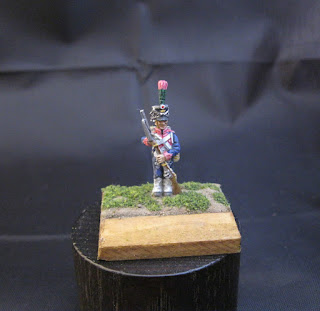Not much left of 2017. Time to make a personal figure check up, eh?
I hope that you all had enjoyable holidays and that your year was good, as well.
My year was pretty cool. It started with playing a background role in an opera (no singing involved, luckily), starting an interesting assignment at a lawyer's office, then quitting again when a far more interesting opportunity showed up in September. Changing my job twice this year, acting at the opera and writing my second novel took plenty of time. This resulted in far lesser blog entries this year. Nevertheless, I still enjoy miniature painting very much.
I have finished one figure setup for my long-term project recently. It's the command figures for my Isembourg regiment.
Bright blue. Really nice.
There's some stuff that I have painted this year but haven't presented on the blog yet. This is mainly because I haven't put them onto bases yet. I'm not quite sure how to assemble the war of 1812 american infantry. For example. But time will show. Or better said: I'll show them to you when it's the right time. :-)
Well - what was it that I put onto my 2017 list? Let's see...
- One single or multi figure display for FIGZ - check
- A multi-figure setup just in case I decide to go to the Lingen show - check
- Completing Baden Jagers and fusiliers - started the fusiliers, Jagers at 80%
- Complete my Russian hussar vignette - *sigh* not even continued
- Complete the SU100 vignette with tank riders - check
- Complete the French departmental guard display (14 figures left) - check
- Finish my Kingdom of Holland setup of Pre-Bardin units until FIGZ (only 4 figures to go) - 2 left
- Finish the Garde de Paris (3 units left) - check
The finishing list of 2017 looks like this:
- Baden Jagers - 8 figures
- Isemburg command - 2 figures
- 1812 American and Canadian infantry - 13 figures
- 1812 US line infantry - 29 figures
- Italian infantry of different units - 8
- Dutch infantry - 1 figure
- French infantry - 31 figures
- Spanish infantry - 1 figure
- figures for contests - 8 figures
- British infantry - 2 figures
Which means that I don't plan too high in numbers for 2018.
Plans are:
- complete the Baden figures
- eventually finish the Russian hussar display
- complete all Strelets Highlanders (at ease) which I bought recently
- paint the Dutch light infantry for having a complete unit overview of Kingdom-of-Holland infantry for this year's FIGZ
- complete all figures for my 'deserters' project
- finish the Boston hussars on my desk
I wish all the best to you for 2018. May it be a successful, healthy and lucky year.


















































